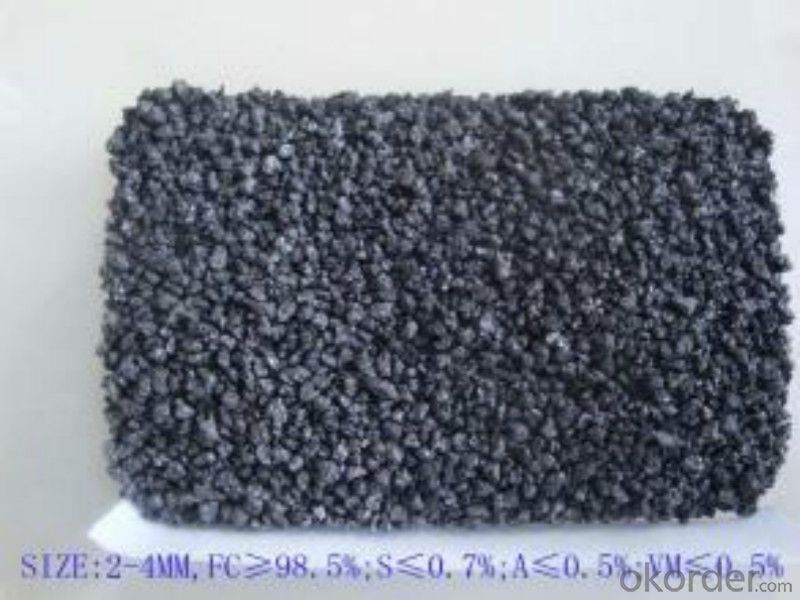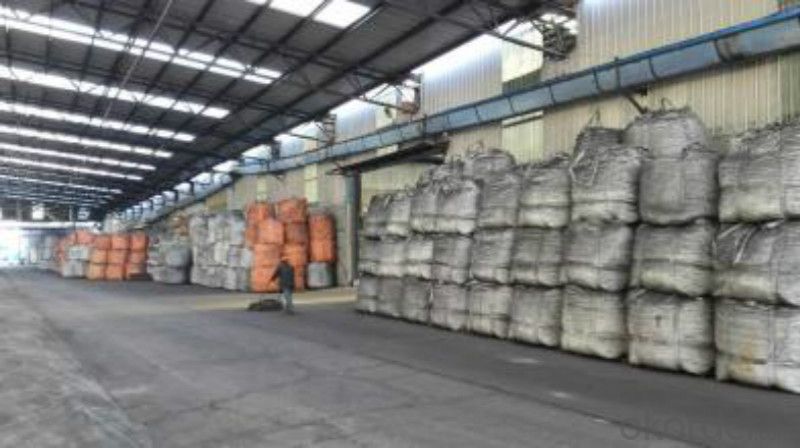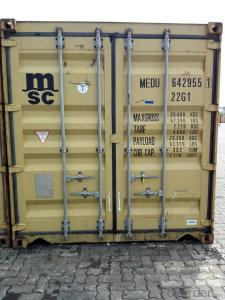Calcined Pitch Coke with Ash 0.5 % for Foundry Plant
- Loading Port:
- Tianjin
- Payment Terms:
- TT OR LC
- Min Order Qty:
- 20 m.t.
- Supply Capability:
- 8000 m.t./month
OKorder Service Pledge
OKorder Financial Service
You Might Also Like
Introduction
Pitch Coke/Coal Tar Pitch is a kind of black brittleness and blocky piece, lustrously at normal temperature. It has special odour and poisonous and can be easily flame when melting, second-grade inflammable solid.
Pitch Coke/Coal Tar Pitch is obtained from powerfully processed coal tar. Compared to petroleum asphalt, the adhesiveness is better. Coal Tar Pitch is high quality tar production with high fixed carbon. It has excellent adhesion, waterproofing and resistance against seawater, oil and various chemicals. In these properties, it is much better than petroleum asphalt tar.
It can be used to produce painting, electrode, pitch coke, and tar felt. It also can be used as fuel and the raw material of asphalt carbon black.
Features:
The morphology, chemistry and crystallinity of recarburisers have a major impact on the overall casting cost. The combined application and cost benefits, which are derived through the use of Desulco, enable foundries to manufacture castings in a highly cost effective manner.
reduces
Recarburiser consumption
Power consumption
Inoculant consumption
MgFeSi consumption
Furnace refractory wear
Scrap rate
Tap to tap time
Slag inclusions risk
Chill
increases
Casting microstructure
Productivity
Process consistency
Carbon Recovery
Compared with calcined petroleum coke, acetylene coke and
graphite electrode scrap, Desulco yields the highest carbon
recovery and fastest dissolution time
Specifications:
CPC | |||
F.C.% | 98.5MIN | 98.5MIN | 98MIN |
ASH % | 0.8MAX | 0.8MAX | 1MAX |
V.M.% | 0.7 MAX | 0.7 MAX | 1 MAX |
SULFUR % | 0. 5MAX | 0. 7MAX | 1MAX |
MOISTURE % | 0.5MAX | 0.5MAX | 1MAX |
Pictures:




FAQ:
1.MOQ:2 Containers |
2.Size:1-3mm,1-5mm,2-6mm,3-5mm and as the customer's requirement |
3.Packing: 1 ton jumbo bag or 25kgs paper in bag |
4.Payment:T/T or L/C at sight |
5.Delivery time: within 15 days after receiving the deposit |
6.Usage: it is as carbon raiser,widely used in steelmaking,casting,casting iron,steel foundry,aluminum metallury. |
- Q:How does carbon impact the availability of natural resources?
- Carbon, in the form of carbon dioxide (CO2), has a significant impact on the availability of natural resources. The burning of fossil fuels, such as coal, oil, and natural gas, releases large amounts of carbon dioxide into the atmosphere. This excessive release of CO2 is responsible for the greenhouse effect, leading to global warming and climate change. One of the most significant effects of climate change is the alteration of natural habitats and ecosystems. Rising temperatures and changing weather patterns directly impact the availability of various natural resources. For instance, higher temperatures can lead to the melting of glaciers and ice caps, affecting the availability of freshwater resources for human consumption and agriculture. Additionally, carbon emissions contribute to the acidification of oceans, which has detrimental effects on marine life. Coral reefs, for example, are highly sensitive to changes in water chemistry, and increased acidity due to elevated CO2 levels can result in their bleaching and eventual death. This not only affects the biodiversity of the oceans but also impacts the availability of fish and other seafood resources that many communities rely on for sustenance and livelihoods. Furthermore, climate change caused by carbon emissions disrupts the balance of ecosystems, leading to the extinction or displacement of numerous plant and animal species. This can have cascading effects on the availability of resources such as timber, medicinal plants, and other valuable natural products sourced from forests and other ecosystems. Moreover, carbon emissions contribute to air pollution, which has detrimental effects on human health. High concentrations of airborne pollutants, including particulate matter, can lead to respiratory diseases and other health issues, exacerbating the strain on healthcare systems and reducing the productivity and overall well-being of communities. To mitigate the negative impacts of carbon emissions on the availability of natural resources, it is crucial to transition to cleaner and more sustainable energy sources, such as renewable energy. This shift would reduce the reliance on fossil fuels and subsequently decrease carbon emissions, helping to preserve and protect our natural resources for future generations.
- Q:How does carbon affect the pH of rainwater?
- The pH of rainwater can be influenced by carbon, which occurs when carbon dioxide (CO2) in the atmosphere dissolves in rainwater. This process is known as the formation of carbonic acid (H2CO3). As a result of this reaction, the pH of rainwater decreases, making it more acidic. The carbonic acid breaks down into hydrogen ions (H+) and bicarbonate ions (HCO3-), which further contribute to the acidity of rainwater. Consequently, higher levels of carbon dioxide in the atmosphere, such as those caused by human activities like the combustion of fossil fuels, can result in an increase in the formation of carbonic acid and subsequently lower the pH of rainwater, leading to the occurrence of acid rain.
- Q:What is a carbon free martensite?
- Thus, I think the non carbon martensite should refer to the martensite formed by ferrous alloy (non carbon), but the carbon in the iron is difficult to be completely removed
- Q:What are the impacts of carbon emissions on the availability of freshwater resources?
- Carbon emissions have a significant impact on the availability of freshwater resources. One of the primary effects is the alteration of the global climate system. Increased carbon emissions lead to the greenhouse effect, which causes global warming. As a result, the Earth's temperature rises, leading to changes in weather patterns and precipitation. These changes in weather patterns can disrupt the water cycle, which crucially affects the availability of freshwater. Warmer temperatures increase evaporation rates, causing more water to be lost from lakes, rivers, and groundwater reservoirs. This leads to a reduction in the overall volume of available freshwater. Furthermore, global warming can exacerbate drought conditions in some regions. As carbon emissions contribute to rising temperatures, the frequency and intensity of droughts increase. This further reduces freshwater availability, as precipitation is limited, and water sources become depleted. Carbon emissions also impact freshwater resources through their effect on melting polar ice caps and glaciers. As the Earth warms, these frozen water sources melt at an accelerated rate, adding additional freshwater to the global water system initially. However, once these ice sources are depleted, the loss of freshwater will be significant. This process not only decreases the overall volume of freshwater available but also affects the quality of freshwater resources, as the melting ice can introduce pollutants and contaminants into the water. Moreover, carbon emissions contribute to ocean acidification, which has indirect effects on freshwater resources. Increased carbon dioxide in the atmosphere is absorbed by the oceans, leading to acidification. This change in the ocean's chemistry can harm marine ecosystems, including coral reefs, which are crucial for maintaining the health of coastal freshwater sources such as aquifers. To mitigate the impacts of carbon emissions on freshwater resources, it is vital to reduce greenhouse gas emissions and transition towards cleaner and renewable energy sources. Additionally, implementing effective water management practices, such as conservation measures, efficient irrigation systems, and the protection of water sources, can help preserve and sustain freshwater resources in the face of climate change and carbon emissions.
- Q:Last night to go to the supermarket to buy 5 batteries, see Toshiba carbon batteries, I finally bought the super alkaline batteries, alkaline batteries and carbon is the difference in where? What kind of battery is best for digital cameras? Thank you
- Alkaline capacity, not drip waterThe camera needs to be chargedBuy expensive at the supermarket
- Q:How does deforestation contribute to carbon dioxide levels in the atmosphere?
- Deforestation plays a significant role in contributing to increased carbon dioxide levels in the atmosphere. Trees act as natural carbon sinks, absorbing carbon dioxide during photosynthesis and storing it in their trunks, branches, and leaves. When forests are cleared or burned down for various purposes such as agriculture, logging, or urbanization, the stored carbon is released back into the atmosphere as carbon dioxide. The removal of trees directly leads to a reduction in the planet's capacity to absorb carbon dioxide, resulting in an imbalance in the carbon cycle. Additionally, deforestation disrupts the carbon cycle by inhibiting the process of photosynthesis, which is essential for converting carbon dioxide into oxygen and organic compounds. Moreover, deforestation indirectly contributes to increased carbon dioxide levels in the atmosphere through the decomposition of organic matter. When trees are cut down or burned, the stored carbon they contain is released into the atmosphere as carbon dioxide, intensifying greenhouse gas emissions. Furthermore, deforestation also impacts the water cycle, leading to drier conditions in the affected areas. This dries out the soil, making it less suitable for plant growth and reducing the potential for carbon absorption through reforestation efforts. The cumulative effect of deforestation on carbon dioxide levels is significant. According to studies, deforestation accounts for approximately 10-15% of global carbon emissions, making it one of the leading contributors to climate change. The increase in atmospheric carbon dioxide levels, along with other greenhouse gases, contributes to the greenhouse effect, trapping heat in the atmosphere and causing global warming. Addressing deforestation is crucial in mitigating climate change and reducing carbon dioxide levels. Implementing sustainable forestry practices, promoting reforestation efforts, and protecting existing forests are essential steps in preserving carbon sinks and reducing greenhouse gas emissions.
- Q:What are the applications of graphite in industry?
- Graphite has various applications in the industry due to its unique properties. It is commonly used as a lubricant in machinery and equipment due to its low friction coefficient. Graphite is also used as an electrode material in batteries, as it can store and release electrical energy efficiently. Additionally, it is used in the production of crucibles, refractory materials, and foundry molds due to its high heat resistance. Graphite is also utilized in the manufacturing of steel and other metals, as it acts as a carbon additive to improve their strength and durability.
- Q:15CrMo seamless steel tube and carbon plate welding fracture what is the reason?
- Possible causes:1. the choice of welding material must be high strength than carbon plate, plastic is better than 15CrMo. Selection may not be based on the welding principle of heterogeneous steel for material selection.2. there is no proper welding procedure.2. preheating is not enough before welding.
- Q:What are the consequences of increased carbon emissions on global trade?
- Global trade can be significantly affected by the increased carbon emissions. One immediate impact is the potential for countries and international agreements to impose stricter environmental regulations and carbon pricing mechanisms. This can result in higher costs for industries heavily reliant on carbon-intensive activities like manufacturing and transportation. Consequently, companies may experience increased production costs, which can be transferred to consumers through higher prices for goods and services. This can negatively impact global trade, as higher costs can reduce demand and hinder international competitiveness. Moreover, industries failing to comply with environmental regulations or carbon reduction targets may face trade barriers or sanctions, further limiting their participation in global trade. Another consequence of increased carbon emissions is the possibility of climate change-related disruptions to supply chains. Infrastructure can be damaged, transportation routes can be disrupted, and the availability and quality of resources can be affected due to rising temperatures, extreme weather events, and sea-level rise. This can cause delays in production and shipping, increased transportation costs, and a higher risk of interruptions in the supply chain. These disruptions can have far-reaching effects on global trade, impacting the flow of goods, services, and investments across borders. Additionally, increased carbon emissions contribute to global warming, which can have long-term implications for agricultural productivity and food security. Changes in temperature and precipitation patterns can result in crop failures, reduced yields, and shifts in agricultural production regions. This can disrupt global food supply chains, leading to price volatility and affecting trade flows. It may even exacerbate food shortages and inequalities. In conclusion, increased carbon emissions have multiple consequences for global trade. Stricter environmental regulations and carbon pricing can raise costs for industries, potentially reducing their competitiveness. Climate change-related disruptions to supply chains can cause delays, increased costs, and interruptions in trade. Furthermore, the impact of global warming on agricultural productivity can significantly affect food security and trade in agricultural commodities.
- Q:What are the consequences of increased carbon emissions on political stability?
- Increased carbon emissions can have significant consequences on political stability. One of the main consequences is the exacerbation of environmental challenges and natural disasters. As carbon emissions contribute to global warming, the frequency and intensity of extreme weather events such as hurricanes, droughts, and flooding increase. These disasters can lead to displacement of communities, destruction of infrastructure, and loss of lives, all of which can have a destabilizing effect on societies. Moreover, the economic impact of increased carbon emissions can also create political instability. As climate change affects agriculture, water resources, and energy production, it can lead to economic disturbances, unemployment, and rising food prices. These economic hardships can fuel social unrest, protests, and even conflicts, particularly in countries that heavily rely on these sectors for their livelihoods. Additionally, the consequences of increased carbon emissions can exacerbate existing social and political tensions. Climate change often disproportionately affects vulnerable populations, such as communities in developing countries or marginalized groups. This inequality can aggravate social inequalities, increase social unrest, and lead to political instability as marginalized communities demand action and justice. Furthermore, the global nature of climate change necessitates international cooperation and agreements to effectively address the issue. However, increased carbon emissions can strain diplomatic relations, particularly between countries that have differing views on climate action. Disagreements over carbon reduction targets, carbon trading mechanisms, and financial contributions can lead to diplomatic tensions and hinder global cooperation, which may consequently impact political stability. In conclusion, increased carbon emissions have far-reaching consequences on political stability. From environmental challenges and natural disasters to economic disturbances and social tensions, the consequences of carbon emissions can strain societies and governments. To ensure political stability, it is imperative that global efforts are made to reduce carbon emissions and mitigate the impacts of climate change.
1. Manufacturer Overview |
|
|---|---|
| Location | |
| Year Established | |
| Annual Output Value | |
| Main Markets | |
| Company Certifications | |
2. Manufacturer Certificates |
|
|---|---|
| a) Certification Name | |
| Range | |
| Reference | |
| Validity Period | |
3. Manufacturer Capability |
|
|---|---|
| a)Trade Capacity | |
| Nearest Port | |
| Export Percentage | |
| No.of Employees in Trade Department | |
| Language Spoken: | |
| b)Factory Information | |
| Factory Size: | |
| No. of Production Lines | |
| Contract Manufacturing | |
| Product Price Range | |
Send your message to us
Calcined Pitch Coke with Ash 0.5 % for Foundry Plant
- Loading Port:
- Tianjin
- Payment Terms:
- TT OR LC
- Min Order Qty:
- 20 m.t.
- Supply Capability:
- 8000 m.t./month
OKorder Service Pledge
OKorder Financial Service
Similar products
New products
Hot products





























